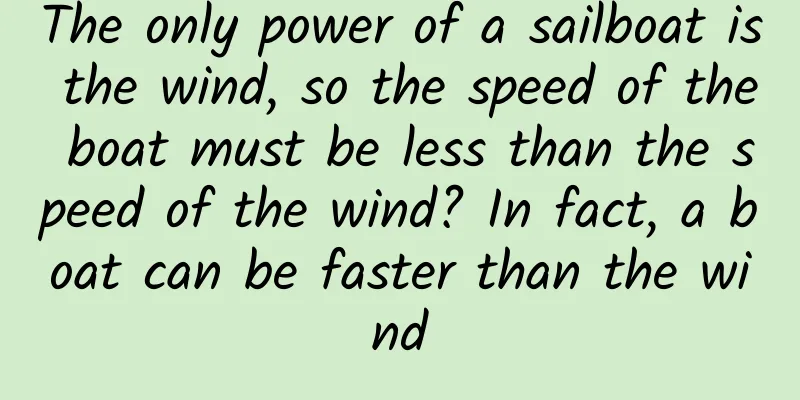The only power of a sailboat is the wind, so the speed of the boat must be less than the speed of the wind? In fact, a boat can be faster than the wind

|
Compared to modern ships powered by large diesel engines, sailboats can definitely be regarded as an ancient means of water transportation, and their appearance can be traced back to more than 5,000 years ago. Unlike ships that consume fossil fuels, sailboats have no power of their own. Their only source of power is the wind, which limits their speed. This is actually easy to understand. The wind blows the sails, and then the sails drive the hull to move. The maximum thrust that the wind can exert on the sails depends on the relative speed of the ship and the wind. For example, at the beginning, the ship is stationary, and the wind speed on the sea is 10m/s. At this time, the relative speed between the ship and the wind is 10m/s. Under the push of the wind, the ship moves and the speed reaches 5m/s. At this time, the relative speed between the ship and the wind becomes 5m/s. It can be seen that as the wind blows the sails, the ship gradually speeds up, the relative speed between the ship and the wind gradually decreases, the thrust brought by the wind becomes weaker and weaker, and the resistance brought to the ship by the water in front increases with the increase in speed. Slowly, the resistance of the sea water and the thrust brought by the wind achieve balance, and the sailboat can no longer continue to accelerate. Obviously, no matter what, the speed of a ship cannot be equal to the speed of the wind, let alone exceed it. But the reality is not like this. Modern sailboats can not only exceed the speed of the wind, but also far exceed it. Why can sailboats outpace the wind? Because sailboats do not rely on the thrust generated by the wind to move forward, they rely on the lift generated by the wind. The sails of sailboats we usually see seem to be a huge curtain, but if we observe the bulging sails from above, we will find that their cross-sectional shapes are very similar to the wings of airplanes, that is to say, the principle of sailboats moving forward is actually the same as the principle of airplanes taking off, both relying on the lift brought by the wind. If you pay attention, you will find that the windward side of the sails of modern sailboats is never facing the wind direction, but facing the wind direction with the side, because the direction of lift is perpendicular to the wind direction. So how is the lift that propels a sailboat forward generated? Of course, it is by using Bernoulli's principle. In water flow or air flow, the slower the flow speed, the greater the pressure, and the faster the flow speed, the lower the pressure. For example, when many people are waiting for the subway, the dense flow of people isolates the air in front and behind. At this time, the subway enters the station, and the high-speed train drives the air in front of the human wall to move at high speed. However, due to the obstruction of the human wall, the air flow behind the human wall is not affected. At this time, the pressure in front of the human wall is small, and the pressure behind is large. This pressure difference will make people feel like being pushed from behind and moving forward, and sometimes it will cause contradictions. This is Bernoulli's principle. The sails of modern sailboats use this principle. From the cross-section of the sail, it can be seen that the two sides of the sail are not the same. The front is raised, while the back is basically flat. This design makes the air flow in front of the sail fast when the wind blows through the sail from the side, while the air flow behind the sail is slow. The difference in air flow rate makes the pressure in front of the sail small and the pressure behind the sail large. The huge pressure difference provides great power to the sailboat. Moreover, the faster the wind speed, the greater the pressure difference between the two sides of the sail, and the speed will increase accordingly. Therefore, the speed of modern sailboats can reach several times the wind speed. Of course, there is another secret behind the speed of modern sailboats. When the ship is stationary and moving forward, the relative speed and direction of the wind and the sail will change. The wind when the sailboat is stationary is generally called true wind, and the wind when it is moving is called apparent wind. As long as the direction of the sail is adjusted properly, the faster the sailboat moves, the stronger the apparent wind will be, and the speed of the ship can be further increased. Of course, this speed increase has a limit, because what changes with the speed of the ship is not only the wind force but also the wind direction. When the speed reaches a certain level, the wind direction is not enough to support the sailboat to continue to speed up, and the speed of the ship reaches its limit. For more information, please follow the official account: sunmonarch |
<<: Why does food spoil? There are more ways to keep food fresh than just freezing it
>>: China's five-year development report card
Recommend
Short video ads are very popular, the key is how to get users to pay for them!
Since mid-2016, short video feeds and Native Ads ...
Seven Swords Zongming's Dragon Head Battle Method Part 3 Video + PDF
The third video + PDF resource introduction of th...
Many provinces will announce college entrance examination results in late July. The 2020 college entrance examination results will be announced
Share this to everyone! Many provinces will annou...
Is product homogeneity serious? 4 dimensions to teach you how to break through successfully!
If you are a company that produces cosmetic conta...
Xiaomi, Huawei, and OPPO are in a "group fight", while Hammer and Meizu have a hard time "surviving"
[[250715]] Sun Tzu said: Therefore, the method of...
10 CSS generation tools for cool UI design effects
According to the latest trends in the design fiel...
International Epilepsy Awareness Day丨If a child has a convulsion, does it mean he has epilepsy? Talk about childhood epilepsy
Author: Lian Di Xinhua Hospital Affiliated to Sha...
What should I do if my mobile phone number is bound to someone else in Kuaishou? How to recover Kuaishou account?
This article mainly introduces what to do if your...
How can the education industry improve overall customer acquisition results?
China's education industry is entering a gold...
Top 10 Marketing Keywords in 2019
The countdown to 2020 begins. It’s time for the y...
Kudoso router: Let your kids do chores to earn time online
According to the National Institutes of Health, Am...
Google's powerful Android UI toolkit dominates Github, here's a guide to getting started
In 2019, Google publicly released a non-bundled t...
Information flow advertising placement case in the wedding industry!
I believe everyone is familiar with information f...
Soil is made of decayed matter? No
Every day, people are born on Earth, and every da...
How to operate your Zhihu? Just read this article!
Whether from the perspective of user growth or us...









